Over the centuries, people have believed a lot of things about European megalithic sites: those monuments or temples of huge stones, intentionally placed by Stone Age people. Some of these beliefs are grounded in good scholarship and archaeology. Some are delightful tidbits of folklore. And some are the wild conjectures of ‘researchers’ with more passion than sense. All are great! Let’s look at some of the more gameable fragments, with a focus on a few particular sites!
This post is brought to you by beloved Patreon backer Colin Wixted. Thanks for helping keep the lights on! If you want to help keep this blog going alongside Colin, head over to the Patreon page – and thank you!
Additionally, I’m delighted to report that thanks to the contributions of all of my Patreon backers, I am finally breaking even financially on the blog. O frabjous day!
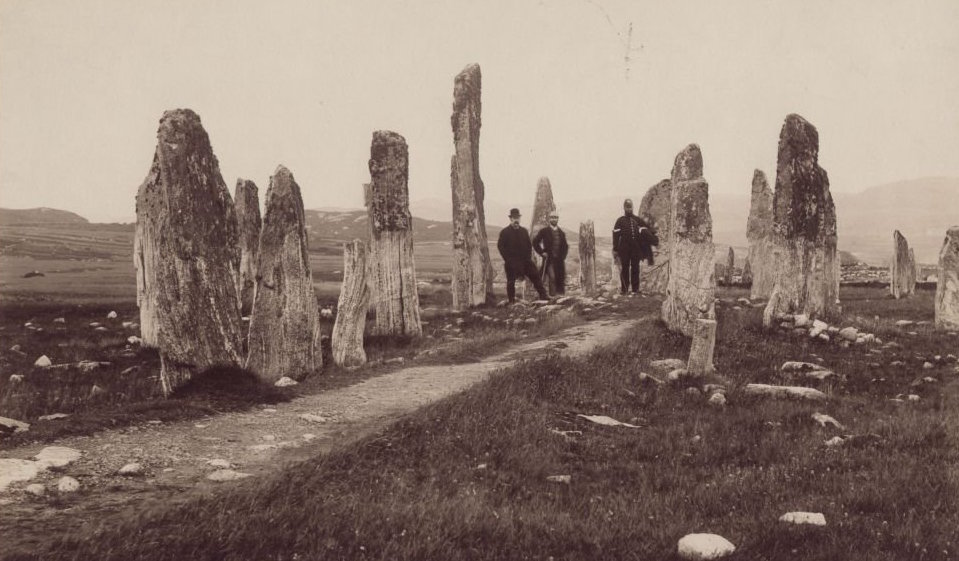
Callanish
The Callanish stones in the Scottish Hebrides are arranged in two perpendicular pairs of parallel lines, forming a cross. There was an underground chamber at the center of the cross, but in 1,000 B.C., one or two millennia after the site was built, someone broke into the chamber, scattered its contents, and planted crops on the land around it.
The site then became overgrown, and five feet of peat grew upon it, making the stones seem much shorter. The peat was cleared in 1857, and for a few years the lower part of stones remained bleached where the peat had been. The same 1857 excavation revealed that the chamber in the center of Callanish contained burned bones and a “specimen of a black unctuous substance”.
This suggests a cool dungeon concept: peat cutting reveals that a minor megalithic site of short stones on a hilltop is actually only the roof of a huge round barrow with tall menhirs stuck atop it like spines! Within are the burned bones and treasure of those buried there and the black, unctuous creature that guards them.
In Callanish’s first mention in print, in 1680, the author reports local tradition claims the stones were men turned to stone by an enchanter. Another tradition says the site is the result of St. Kieran, who turned to stone a group of pagan giants meeting to oppose Christianity. Another has a ‘Shining One’ who walked up the site’s avenue at midsummer sunrise, summoned by the cuckoo’s call and wearing a cloak of feathers.
A range of hills viewed from Callanish looks like a sleeping woman. Some locals call her ‘Cailleach na Mointeach’, the old hag of the moors. New Agers believe she’s connected to the site. In settings were beliefs can become true (like Unknown Armies), the Cailleach may be a newly-arisen entity who falsely believes she is ancient!
Half a mile southwest of Callanish, there’s a small stone circle. One of the stones is covered in cracks. An 1858 paper sought to interpret these natural cracks as an intentional script, maybe even the Ogham script of the medieval Irish. This is simply untrue, but in your fictional setting, the natural cracks in megaliths may represent some secret form of writing.
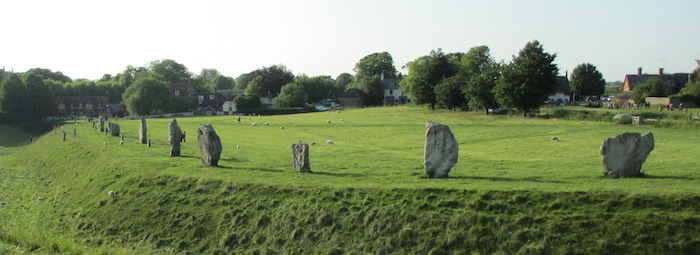
Image credit: Looneytics. Released under a CC BY-SA 3.0 license.
Avebury
Avebury, in Wiltshire, England, is the largest stone circle in the world. It’s so big that today a village sits within it! That’s actually been a problem as large parts of the circle were demolished in the early modern period to make way for construction. Most of the stones present in the village today were put up in the 1930s to try to restore some of Avebury’s grandeur.
Avebury is a large stone circle with two separate circles inside in it. The stones of the outer circle and the south inner circle are spaced roughly equally far apart, which some have used to suggest the builders knew how to work with pi. Others point out that it could indicate the ancients spent an afternoon dicking around with some rope, a few stakes, and a little trial and error before they brought in the stones.
Two dowsers claim that Avebury is the site of a crossing of fields of male and female energy that follow the ‘Michael’ ley line. Naturally, dowsing, the Michael line, ley lines more broadly, and the existence of fields of male and female energy are completely unsupported by actual evidence. This one’s just factually untrue from beginning to end.
At your table, Avebury is a terrific red herring. Set an ordinary adventure, like a murder mystery, in a village located inside an Avebury-style stone circle. Have dowsers and crackpot mathematicians be major NPCs in the adventure. The players will keep themselves well-entertained looking for how the ‘Mysteries of the Ancients’ explain what’s happening in the village, but in truth nothing of the sort is going on!
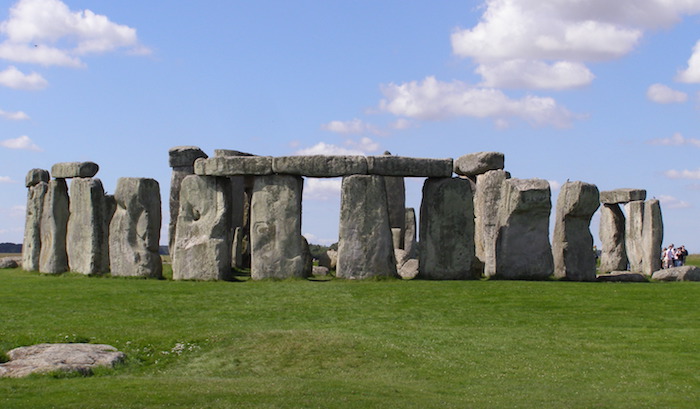
Stonehenge
As long as people have been writing about Stonehenge, in Wiltshire, they’ve been giving amazing origins for it. Geoffery of Monmouth’s 1150 The History of the Kings of Britain says that Merlin built Stonehenge using gears and giants. In the 1600s, noted architect Inigo Jones argued the site was built by the Romans – an unpopular opinion, since folks at the time believed it was built by druids! (In fact, Stonehenge predates the druids by several thousand years.) In the 1700s, antiquarian William Stukely argued that Stonehenge was built and used by the druids, but that the druids were Christians, and had learned the true religion from Biblical patriarchs who visited England before Christ was born.
Astrologer Robin Heath did some delightful nonsense with measurements on Stonehenge. He pointed out that the outer circumference of the site’s ‘Sarsen circle’ is about 328 feet and that twelve lunar orbital periods last about 328 days. The diameter of the farther-out Aubrey circle is about 10,786 inches, and the product of the length of the solar year and the lunar month (in days) is about 10,786. Obviously, this is a coincidence created by trying every conceivable combination of lunar and solar phenomena until you find something close. But if you take it seriously, it implies this delightful situation where Stonehenge’s builders were using modern inches and feet, units which, in real history, varied considerably in length over the centuries and from place to place. This suggests either that Stonehenge’s builders had access to time travel or that some outside entity (perhaps even God Himself) has set the length of the inch and the foot, and done so at least twice.
At your table, why not let all of these builders fight it out? Merlin and his giants, the Romans, Christian druids, and time travelers with modern tape measures duking it out in the streets of nearby Amesbury (the oldest continually-settled place in Britain) would be one heck of an adventure hook!
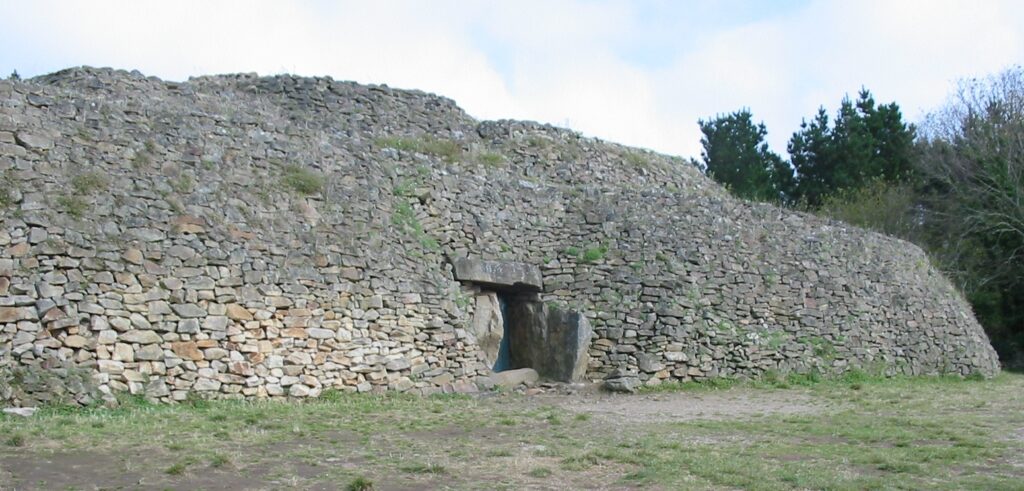
Carnac
Carnac, in Brittany, northwestern France, is best-known for its miles-long parallel lines of standing stones. As in Stonehenge, old local folklore claimed a lost race of giants built the site, and Victorian-era popular folklore claimed the stones were rows of petrified Roman soldiers.
But the real wild stuff comes from three other sites at Carnac: a cairn, a dolmen, and a tomb. These three structures share three parts of the same carved image! The top part of a great cairn on the tiny island of Gavrinis has several rock carvings on it showing animals and abstract designs. These carvings go right up to the edge of the slab – and continue on the ceiling of a nearby dolmen and a tomb! These three slabs fit together, and once must have been a single fourteen-meter standing stone decorated with carvings. After the stone fell over and broke, the locals used the pieces to build new structures, but obscured the old carvings by flipping the stones so the carvings are on the hidden side. This implies that – in real life! – existing megalithic sites may be made from the remains of even older and grander sites. In fiction, a modern megalithic site could be affiliated with multiple distinct eras of phenomena: ghosts from 3,000 B.C., lizard people from 10,000 B.C., and Yithians from 65 million years ago!
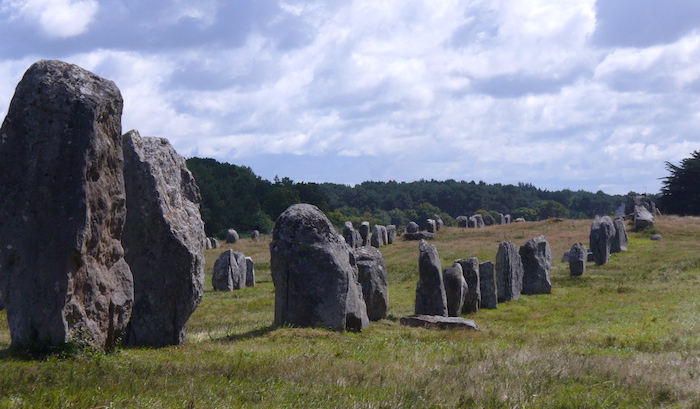
Image credit: Steffen Heilfort. Released under a CC BY-SA 3.0 license.
Finally, we have some generalized beliefs that don’t apply to any site specifically. For whatever reason, megalithic sites attract pseudoscientists. These are the sorts of bad researchers who will look at a map of densely-packed sites, draw a line through it, point to a half-dozen sites that fall near the line (ignoring the dozens nowhere near it) and call it proof of ley lines. Or who match the alignment of any stone they can (with a liberal margin of error) to an astronomical phenomenon, no matter how obscure or irrelevant to the ancients. But it’s the pseudoscientists’ bad math that’s gameable here!
They go to considerable lengths to describe complex mathematical relationships in the layout of individual sites. First, they give themselves a considerable margin of error. Is the stone two feet to the left of where it needs to be for the math to work? Eh, treat it like it’s in the right place. And second, they overlook the fact that if these sites were laid out by a couple of guys measuring things off with a rope, complex mathematical relationships will arise as a natural emergent property. You saw the same thing in the 1980s with paranormal researchers finding all kinds of complicated mathematical patterns in crop circles that were later revealed to be hoaxes created by two guys with a rope and a board. Worse, these patterns often rely on inventing a new point, then arguing that it forms a right triangle with these two stones – but if you can just invent a vertex, literally any two stones can form a right triangle.
In a fictional setting, though, you could take this at face value: Neolithic people intentionally built their sites according to absurdly complicated mathematical patterns, but couldn’t have been bothered to put their stones in exactly the right the places. If so, everything they did was surely equally Byzantine and haphazard! The traps that guard their treasures are breathtakingly complex Rube Goldberg devices, but can be undone by removing a peg they never bothered to hammer firmly into place. They sussed out the orbit of a comet that only comes ‘round once every five thousand years and built Stonehenge so the comet’s next appearance would summon the Old Ones. But the ritual can be stopped just by holding up a blanket so the comet’s light doesn’t fall on one of the stones.
–
Source: Megalith: Studies in Stone by Crowhurst, Francis, Heath, Mansell, Newman, Ponting, Strong, and Thom (2018)






